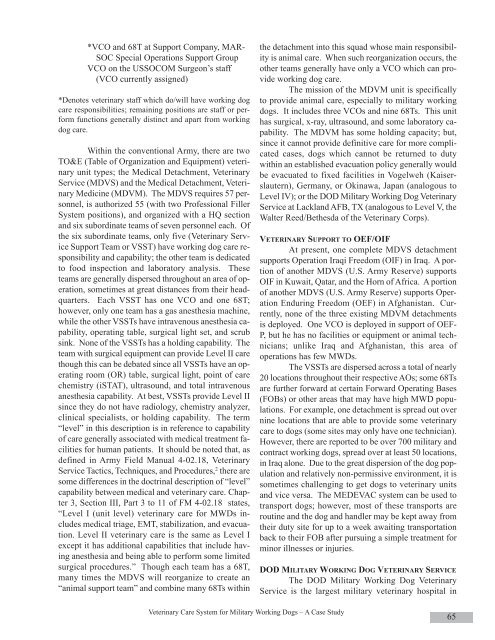Spring 07 front cover - United States Special Operations Command
Spring 07 front cover - United States Special Operations Command
Spring 07 front cover - United States Special Operations Command
- No tags were found...
You also want an ePaper? Increase the reach of your titles
YUMPU automatically turns print PDFs into web optimized ePapers that Google loves.
*VCO and 68T at Support Company, MAR-SOC <strong>Special</strong> <strong>Operations</strong> Support GroupVCO on the USSOCOM Surgeon’s staff(VCO currently assigned)*Denotes veterinary staff which do/will have working dogcare responsibilities; remaining positions are staff or performfunctions generally distinct and apart from workingdog care.Within the conventional Army, there are twoTO&E (Table of Organization and Equipment) veterinaryunit types; the Medical Detachment, VeterinaryService (MDVS) and the Medical Detachment, VeterinaryMedicine (MDVM). The MDVS requires 57 personnel,is authorized 55 (with two Professional FillerSystem positions), and organized with a HQ sectionand six subordinate teams of seven personnel each. Ofthe six subordinate teams, only five (Veterinary ServiceSupport Team or VSST) have working dog care responsibilityand capability; the other team is dedicatedto food inspection and laboratory analysis. Theseteams are generally dispersed throughout an area of operation,sometimes at great distances from their headquarters.Each VSST has one VCO and one 68T;however, only one team has a gas anesthesia machine,while the other VSSTs have intravenous anesthesia capability,operating table, surgical light set, and scrubsink. None of the VSSTs has a holding capability. Theteam with surgical equipment can provide Level II carethough this can be debated since all VSSTs have an operatingroom (OR) table, surgical light, point of carechemistry (iSTAT), ultrasound, and total intravenousanesthesia capability. At best, VSSTs provide Level IIsince they do not have radiology, chemistry analyzer,clinical specialists, or holding capability. The term“level” in this description is in reference to capabilityof care generally associated with medical treatment facilitiesfor human patients. It should be noted that, asdefined in Army Field Manual 4-02.18, VeterinaryService Tactics, Techniques, and Procedures, 2 there aresome differences in the doctrinal description of “level”capability between medical and veterinary care. Chapter3, Section III, Part 3 to 11 of FM 4-02.18 states,“Level I (unit level) veterinary care for MWDs includesmedical triage, EMT, stabilization, and evacuation.Level II veterinary care is the same as Level Iexcept it has additional capabilities that include havinganesthesia and being able to perform some limitedsurgical procedures.” Though each team has a 68T,many times the MDVS will reorganize to create an“animal support team” and combine many 68Ts withinthe detachment into this squad whose main responsibilityis animal care. When such reorganization occurs, theother teams generally have only a VCO which can provideworking dog care.The mission of the MDVM unit is specificallyto provide animal care, especially to military workingdogs. It includes three VCOs and nine 68Ts. This unithas surgical, x-ray, ultrasound, and some laboratory capability.The MDVM has some holding capacity; but,since it cannot provide definitive care for more complicatedcases, dogs which cannot be returned to dutywithin an established evacuation policy generally wouldbe evacuated to fixed facilities in Vogelweh (Kaiserslautern),Germany, or Okinawa, Japan (analogous toLevel IV); or the DOD Military Working Dog VeterinaryService at Lackland AFB, TX (analogous to Level V, theWalter Reed/Bethesda of the Veterinary Corps).VETERINARY SUPPORT TO OEF/OIFAt present, one complete MDVS detachmentsupports Operation Iraqi Freedom (OIF) in Iraq. A portionof another MDVS (U.S. Army Reserve) supportsOIF in Kuwait, Qatar, and the Horn of Africa. A portionof another MDVS (U.S. Army Reserve) supports OperationEnduring Freedom (OEF) in Afghanistan. Currently,none of the three existing MDVM detachmentsis deployed. One VCO is deployed in support of OEF-P, but he has no facilities or equipment or animal technicians;unlike Iraq and Afghanistan, this area ofoperations has few MWDs.The VSSTs are dispersed across a total of nearly20 locations throughout their respective AOs; some 68Tsare further forward at certain Forward Operating Bases(FOBs) or other areas that may have high MWD populations.For example, one detachment is spread out overnine locations that are able to provide some veterinarycare to dogs (some sites may only have one technician).However, there are reported to be over 700 military andcontract working dogs, spread over at least 50 locations,in Iraq alone. Due to the great dispersion of the dog populationand relatively non-permissive environment, it issometimes challenging to get dogs to veterinary unitsand vice versa. The MEDEVAC system can be used totransport dogs; however, most of these transports areroutine and the dog and handler may be kept away fromtheir duty site for up to a week awaiting transportationback to their FOB after pursuing a simple treatment forminor illnesses or injuries.DOD MILITARY WORKING DOG VETERINARY SERVICEThe DOD Military Working Dog VeterinaryService is the largest military veterinary hospital inVeterinary Care System for Military Working Dogs – A Case Study65
















